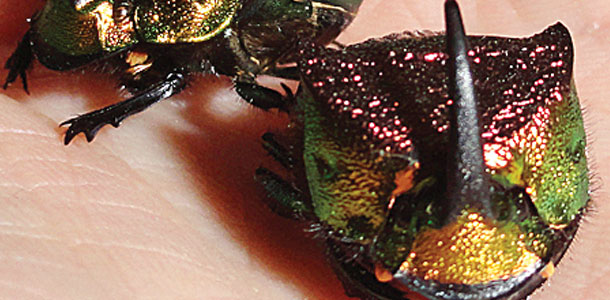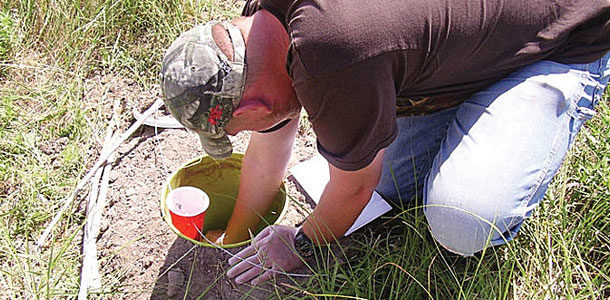There are approximately 7,000 species of dung beetles in the world, with over 2,000 occurring in Africa alone. Conservatively, the value of dung beetles in the U.S. is approximately $380 million annually through minimizing yield loss, livestock pests and fertilizer use. Meanwhile, around $800 million is spent annually to control livestock pests in the U.S.
For such a small creature, their job description includes control of dung-breeding flies and parasites, nutrient cycling, reduction of greenhouse gases, soil aeration and increasing yield potential of rangeland.
They are also an excellent indicator of biodiversity, with some species playing a role in pollination and plant seed dispersal.
Dung beetles are divided into three behavioral groups: rollers, tunnelers and dwellers. Rollers are characterized by the female fashioning a brood ball, which the male and female roll away from the dung pat.
A single egg is deposited in the brood ball, where the larva develops through its instars. Tunnelers bury dung into the soil directly beneath the dung pat to lay their eggs, while dwellers deposit their eggs into the main dung pat, where they will develop into adults.
Even though the three groups are distinct in behaviors, competition between adults and larvae for food and space is high.
Rollers and tunnelers are often more adept at swift and efficient dung removal, but this depends on numerous factors including beetle size, burial speed and depth.
Although there is a great deal of competition, dung beetle species vary markedly in their utilization of dung, and often there is a competitive hierarchy. This competition helps speed decomposition by dung beetles.
Individual cattle commonly deposit between 10 to 20 dung pats each day, with each pat ultimately covering rangeland plants and grasses otherwise available for livestock.
These pats have been known to remain undegraded for up to four years without dung beetle activity, resulting in an area that remains ungrazed by livestock.
Dung beetles significantly increase the rate of dung decomposition, with the larvae being able to consume up to 100 percent of their bodyweight per day until becoming adults.
Through dung beetles regularly removing livestock feces, an additional 5 to 10 percent increase in available range forage can be achieved.
Anyone who has spent much time around livestock can tell you that where there are cattle, there are flies. Many flies that are considered pests of livestock use manure as a breeding ground.
Each year, horn flies cause an estimated $730 million loss to the cattle industry. However, with adequate supplies of dung beetles, horn fly numbers have been shown to be reduced by as much as 95 percent.
Dung beetle activity has also been shown to reduce numbers and resurgence of parasitic larvae within the manure. Dung beetles use manure for both food and reproduction, and the faster the pat can be removed by beetles, the less opportunity flies have to use it.
The burial activity of dung beetles has a positive impact on soil nutrients, pH and cation exchange capacity, which positively influences forage growth.
For example, burial of dung by Onthophagus australis Guerin resulted in significant increase in the yield of Japanese millet, Echinochloa crus-galli var. frumentacea.
When dung alone was placed on the soil surface within the trials, yield was 17.3 g compared to 31.3 g with beetles present.
Dung beetles are bio-indicators of a healthy ecosystem, and if there are no beetles present, the potential yield is not being met. When stocking rates are high, dung beetles may become ineffective.
Overgrazing can result in reduced surface cover, increased surface temperature, increased runoff, reduced soil moisture and an eventual change in plant community composition. Intensive and rough grazing has been observed to reduce dung beetle abundance.
With overstocking and drought, as much as 85 percent of a pasture’s biomass can be consumed by herbivores. Dung beetles efficiently cycle nutrients into the soil and create healthier rangelands and reduce greenhouse gas emissions.
If dung is not removed, up to 80 percent of the nitrogen is lost to the atmosphere.
In addition, burial of animal dung by the beetles increases soil aeration and the eventual leaching of water and nutrients into the soil.
Soil aeration resulting from dung burial enhances the role dung beetles play in nutrient cycling. Soil aeration lowers runoff of surface wastes and aids in reduction of water contamination and algal blooms.
Dung beetles have adapted to perform several jobs in a wide variety of ecosystems, and many are highly specialized. Depending upon species, dung beetles may have specific preference toward dung and dung odor.
Dung beetles have also been shown to segregate based upon habitat and soil type, nocturnal or diurnal activity, seasonality, light intensity and elevation.
That being said, having a diversity of livestock species and a grazing strategy that provides an adequate supply of congregated dung can go a long way in maximizing the abundance and diversity of dung beetles on rangeland. FG
PHOTOS
PHOTO 1: A pitfall trap is a 5-gallon bucket dug into the ground level with the soil. The lid is separated from the bucket by sticks, allowing dung beetles to crawl in, but unable to fly out. Photo courtesy of Sean Whipple.
What I learned
How would a producer know whether dung beetles are present in pastures?
Answer: A producer can either set a pitfall trap (using a bucket set into the ground with the top at ground level) baited with dung or dig through cow pats to find beetles.
How would a producer encourage more dung beetle colonies?
Answer: As a rule, dung beetles can be encouraged by increasing the congregation of dung on a property (through grazing practices) and sound range management practices.
Having a diversity of livestock (cattle, horses, sheep, goats, pigs) has been shown to increase dung beetle diversity and abundance. Also, treating livestock with veterinary pharmaceuticals at colder times of the year when most dung beetles are inactive has proven beneficial.

Sean D. Whipple
Field Development Representative
Isk Biosciences









